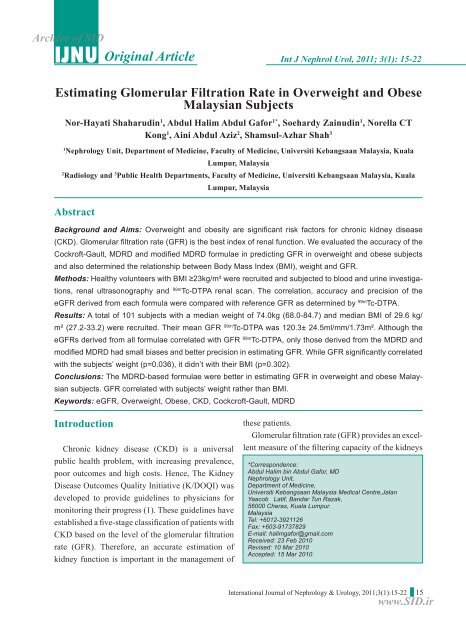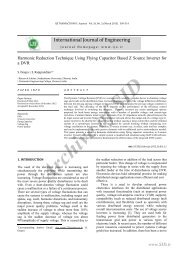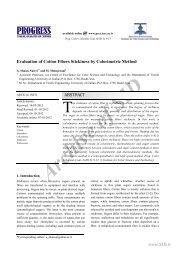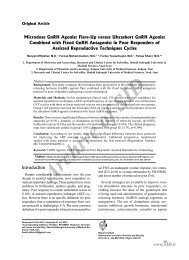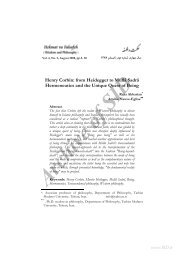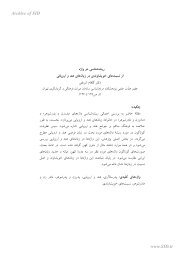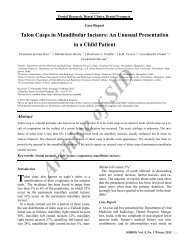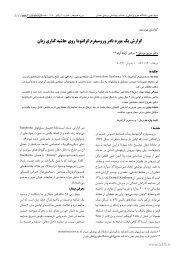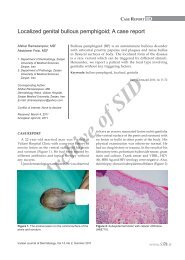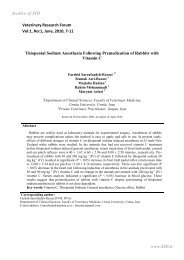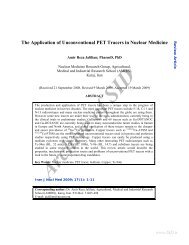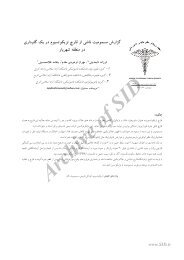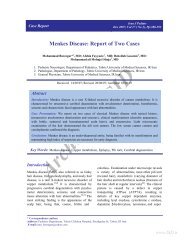estimating glomerular filtration rate in overweight and obese ...
estimating glomerular filtration rate in overweight and obese ...
estimating glomerular filtration rate in overweight and obese ...
Create successful ePaper yourself
Turn your PDF publications into a flip-book with our unique Google optimized e-Paper software.
Archive of SID<br />
IJNU<br />
Estimat<strong>in</strong>g Glomerular Filtration Rate <strong>in</strong> Overweight <strong>and</strong> Obese<br />
Malaysian Subjects<br />
Nor-Hayati Shaharud<strong>in</strong> 1 , Abdul Halim Abdul Gafor 1* , Soehardy Za<strong>in</strong>ud<strong>in</strong> 1 , Norella CT<br />
Kong 1 , A<strong>in</strong>i Abdul Aziz 2 , Shamsul-Azhar Shah 3<br />
1 Nephrology Unit, Department of Medic<strong>in</strong>e, Faculty of Medic<strong>in</strong>e, Universiti Kebangsaan Malaysia, Kuala<br />
Lumpur, Malaysia<br />
2 Radiology <strong>and</strong> 3 Public Health Departments, Faculty of Medic<strong>in</strong>e, Universiti Kebangsaan Malaysia, Kuala<br />
Abstract<br />
Lumpur, Malaysia<br />
Int J Nephrol Urol, 2011; 3(1): 15-22<br />
Background <strong>and</strong> Aims: Overweight <strong>and</strong> obesity are significant risk factors for chronic kidney disease<br />
(CKD). Glomerular <strong>filtration</strong> <strong>rate</strong> (GFR) is the best <strong>in</strong>dex of renal function. We evaluated the accuracy of the<br />
Cockroft-Gault, MDRD <strong>and</strong> modified MDRD formulae <strong>in</strong> predict<strong>in</strong>g GFR <strong>in</strong> <strong>overweight</strong> <strong>and</strong> <strong>obese</strong> subjects<br />
<strong>and</strong> also determ<strong>in</strong>ed the relationship between Body Mass Index (BMI), weight <strong>and</strong> GFR.<br />
Methods: Healthy volunteers with BMI ≥23kg/m² were recruited <strong>and</strong> subjected to blood <strong>and</strong> ur<strong>in</strong>e <strong>in</strong>vestigations,<br />
renal ultrasonography <strong>and</strong> 99mTc-DTPA renal scan. The correlation, accuracy <strong>and</strong> precision of the<br />
eGFR derived from each formula were compared with reference GFR as determ<strong>in</strong>ed by 99mTc-DTPA. Results: A total of 101 subjects with a median weight of 74.0kg (68.0-84.7) <strong>and</strong> median BMI of 29.6 kg/<br />
m² (27.2-33.2) were recruited. Their mean GFR 99mTc-DTPA was 120.3± 24.5ml/mm/1.73m². Although the<br />
eGFRs derived from all formulae correlated with GFR 99mTc-DTPA, only those derived from the MDRD <strong>and</strong><br />
modified MDRD had small biases <strong>and</strong> better precision <strong>in</strong> <strong>estimat<strong>in</strong>g</strong> GFR. While GFR significantly correlated<br />
with the subjects’ weight (p=0.036), it didn’t with their BMI (p=0.302).<br />
Conclusions: The MDRD-based formulae were better <strong>in</strong> <strong>estimat<strong>in</strong>g</strong> GFR <strong>in</strong> <strong>overweight</strong> <strong>and</strong> <strong>obese</strong> Malaysian<br />
subjects. GFR correlated with subjects’ weight rather than BMI.<br />
Keywords: eGFR, Overweight, Obese, CKD, Cockcroft-Gault, MDRD<br />
Introduction<br />
Orig<strong>in</strong>al Article<br />
Chronic kidney disease (CKD) is a universal<br />
public health problem, with <strong>in</strong>creas<strong>in</strong>g prevalence,<br />
poor outcomes <strong>and</strong> high costs. Hence, The Kidney<br />
Disease Outcomes Quality Initiative (K/DOQI) was<br />
developed to provide guidel<strong>in</strong>es to physicians for<br />
monitor<strong>in</strong>g their progress (1). These guidel<strong>in</strong>es have<br />
established a five-stage classification of patients with<br />
CKD based on the level of the <strong>glomerular</strong> <strong>filtration</strong><br />
<strong>rate</strong> (GFR). Therefore, an accu<strong>rate</strong> estimation of<br />
kidney function is important <strong>in</strong> the management of<br />
these patients.<br />
Glomerular <strong>filtration</strong> <strong>rate</strong> (GFR) provides an excel-<br />
lent measure of the filter<strong>in</strong>g capacity of the kidneys<br />
*Correspondence:<br />
Abdul Halim b<strong>in</strong> Abdul Gafor, MD<br />
Nephrology Unit,<br />
Department of Medic<strong>in</strong>e,<br />
Universiti Kebangsaan Malaysia Medical Centre,Jalan<br />
Yaacob Latif, B<strong>and</strong>ar Tun Razak,<br />
56000 Cheras, Kuala Lumpur.<br />
Malaysia<br />
Tel: +6012-3921126<br />
Fax: +603-91737829<br />
E-mail: halimgafor@gmail.com<br />
Received: 23 Feb 2010<br />
Revised: 10 Mar 2010<br />
Accepted: 15 Mar 2010<br />
International Journal of Nephrology & Urology, 2011;3(1):15-22 15<br />
www.SID.ir
Archive of SID<br />
16<br />
Glomerular Filtration Rate <strong>in</strong> Obese<br />
<strong>and</strong> is considered to be the best <strong>in</strong>dex of renal function<br />
(2, 3). Inul<strong>in</strong> clearance has long been regarded<br />
as the gold st<strong>and</strong>ard for measur<strong>in</strong>g GFR, but the<br />
procedure is costly, time consum<strong>in</strong>g <strong>and</strong> difficult to<br />
perform (3). Creat<strong>in</strong><strong>in</strong>e has many advantages as a<br />
<strong>filtration</strong> marker <strong>and</strong> its measurement is cost effective<br />
(3). S<strong>in</strong>ce the early 1970s, several formulae for<br />
<strong>estimat<strong>in</strong>g</strong> creat<strong>in</strong><strong>in</strong>e clearance <strong>and</strong> GFR from serum<br />
creat<strong>in</strong><strong>in</strong>e have been developed. Although there have<br />
been many studies validat<strong>in</strong>g each formula, select<strong>in</strong>g<br />
the best <strong>in</strong> a given patient rema<strong>in</strong>s a topic of debate<br />
(4). Additionally, measurement of creat<strong>in</strong><strong>in</strong>e clearance<br />
by us<strong>in</strong>g timed ur<strong>in</strong>e collection e.g. 24-hour<br />
ur<strong>in</strong>e collection, does not provide a more accu<strong>rate</strong><br />
estimate of GFR than do prediction equations (4,<br />
5).<br />
The Cockcroft-Gault (CG) formula rema<strong>in</strong>s the<br />
most widely used method for <strong>estimat<strong>in</strong>g</strong> GFR <strong>in</strong><br />
cl<strong>in</strong>ical practice. A more recently developed formula<br />
is that of the Modification of Diet <strong>in</strong> Renal Disease<br />
(MDRD 1) study <strong>in</strong> the U.S (6). It automatically<br />
estimates body surface area (BSA)-<strong>in</strong>dexed GFR<br />
<strong>in</strong> units of ml/m<strong>in</strong>/1.73m2 as opposed to the results<br />
with the CG formula. In 2002, Levey <strong>and</strong> coworkers<br />
proposed a modified MDRD equation (MDRD<br />
2) us<strong>in</strong>g less variables <strong>and</strong> this correlated well with<br />
MDRD 1 (7).<br />
The MDRD 1 <strong>and</strong> MDRD 2 formulae have been<br />
evaluated <strong>in</strong> various subgroups such as African<br />
Americans with CKD, Caucasian patients with<br />
kidney disease <strong>and</strong> normal serum creat<strong>in</strong><strong>in</strong>e, type<br />
1 diabetics without nephropathy, type 2 diabetics<br />
with <strong>and</strong> without nephropathy, newly diagnosed<br />
type 2 diabetics, elderly patients with CKD, patients<br />
with chronic heart failure, potential renal transplant<br />
donors <strong>and</strong> recipients as well as <strong>in</strong> normal subjects<br />
(8-16). Whether the MDRD 1 <strong>and</strong> MDRD 2 formulae<br />
are applicable to other populations require further<br />
evaluation.<br />
Serum creat<strong>in</strong><strong>in</strong>e is affected by many factors such<br />
as age, gender, race, muscle mass, prote<strong>in</strong> <strong>in</strong>take,<br />
International Journal of Nephrology & Urology, 2011;3(1):15-22<br />
nutritional status, hydration status, drugs <strong>and</strong> renal<br />
disease (2, 3). On the other h<strong>and</strong>, measurement of<br />
creat<strong>in</strong><strong>in</strong>e clearance by 24-hour ur<strong>in</strong>e collection may<br />
overestimate GFR s<strong>in</strong>ce creat<strong>in</strong><strong>in</strong>e is secreted as well<br />
as filtered by the renal tubules (3). The delay for the<br />
collection <strong>and</strong> analysis <strong>and</strong> the difficulties <strong>in</strong> ensur<strong>in</strong>g<br />
complete ur<strong>in</strong>e collection are other disadvantages<br />
of this approach to GFR estimation. Various radioisotopic<br />
<strong>filtration</strong> markers for <strong>estimat<strong>in</strong>g</strong> GFR have<br />
also been studied (17, 18). Perrone et al concluded<br />
that the ur<strong>in</strong>ary clearance of exogenous radioactive<br />
markers such as 125I-iothalamate <strong>and</strong> 99mTc-DTPA also provided accu<strong>rate</strong> measures of GFR (18). However,<br />
these methods are <strong>in</strong>vasive, time consum<strong>in</strong>g,<br />
expensive, not readily available <strong>and</strong> expose subjects<br />
to radiation.<br />
Obesity is a common, chronic <strong>and</strong> complex<br />
metabolic disorder with multifactorial aetiologies<br />
occur<strong>in</strong>g throughout the world. The Asia Pacific<br />
Guidel<strong>in</strong>es def<strong>in</strong>e <strong>overweight</strong> as a body mass <strong>in</strong>dex<br />
(BMI) between 23.0-24.9 kg/m2 <strong>and</strong> <strong>obese</strong> as a BMI<br />
over 25.0 kg/m2 (19). The <strong>rate</strong>s of obesity <strong>in</strong> develop<strong>in</strong>g<br />
countries have tripled over the past 20 years<br />
(20). Several studies have demonst<strong>rate</strong>d obesity as<br />
a risk factor for CKD <strong>and</strong> end stage renal disease<br />
(ESRD) (21, 22).<br />
Us<strong>in</strong>g serum creat<strong>in</strong><strong>in</strong>e to calculate GFR can<br />
be mislead<strong>in</strong>g as <strong>obese</strong> <strong>and</strong> <strong>overweight</strong> <strong>in</strong>dividuals<br />
can have disproportionately lower serum creat<strong>in</strong><strong>in</strong>e<br />
compared to the body weight as fat does not secrete<br />
creat<strong>in</strong><strong>in</strong>e. The application of these formulae to this<br />
cohort is aga<strong>in</strong> limited by the lack of validation.<br />
Hence, this study was conducted to evaluate the<br />
accuracy of these formulae <strong>in</strong> these subjects <strong>in</strong> our<br />
country.<br />
Our primary objective was to evaluate the accuracy<br />
of the estimated GFR (eGFR) derived from<br />
the various formulae compared to the reference GFR<br />
as measured by the 99mTc-DTPA radioisotope scan<br />
<strong>in</strong> <strong>overweight</strong> <strong>and</strong> <strong>obese</strong> Malaysian subjects. These<br />
formulae <strong>in</strong>cluded Cockcroft-Gault corrected for the<br />
www.SID.ir
Archive of SID<br />
body surface area BSA (CGBSA), orig<strong>in</strong>al MDRD<br />
(MDRD 1) <strong>and</strong> modified MDRD (MDRD 2). Our<br />
secondary objective was to study the association<br />
between true GFR with subjects’ weights <strong>and</strong> BMI.<br />
Materials <strong>and</strong> Methods<br />
This was a cross-sectional, s<strong>in</strong>gle centre study<br />
<strong>in</strong>volv<strong>in</strong>g <strong>overweight</strong> <strong>and</strong> <strong>obese</strong> Malaysian subjects.<br />
The study protocol was approved by the Medical<br />
Research <strong>and</strong> Ethics Committee of the Faculty of<br />
Medic<strong>in</strong>e, Universiti Kebangsaan Malaysia (Research<br />
Grant FF-160-2006). Healthy volunteers<br />
aged 18-55 years with BMI > 23 kg/m2 were eligible<br />
for this study. Subjects with the follow<strong>in</strong>g conditions<br />
were excluded: acute <strong>and</strong> chronic medical illnesses,<br />
history of hospital admission with<strong>in</strong> one month prior<br />
to the study, history of tak<strong>in</strong>g traditional medications<br />
<strong>and</strong>/or non-steroidal anti-<strong>in</strong>flammatory drugs<br />
(NSAIDs) <strong>and</strong>/or angiotens<strong>in</strong> convert<strong>in</strong>g enzyme<br />
<strong>in</strong>hibitor (ACEI) or angiotens<strong>in</strong> receptor blocker<br />
(ARB) with<strong>in</strong> one month prior to the study, pregnant<br />
women, lactat<strong>in</strong>g mothers <strong>and</strong> those with eGFR of ≤<br />
30ml/m<strong>in</strong> on basel<strong>in</strong>e <strong>in</strong>vestigations.<br />
The study population was selected from volunteers<br />
who fulfilled the study criteria <strong>and</strong> gave <strong>in</strong>formed<br />
consent. A full history <strong>and</strong> physical exam<strong>in</strong>ation<br />
were performed. Subjects with underly<strong>in</strong>g diseases,<br />
on medications or tak<strong>in</strong>g herbal or food supplements<br />
were excluded. Selected subjects were scheduled<br />
for two visits. Prior to the first visit, subjects were<br />
advised to fast <strong>and</strong> to avoid smok<strong>in</strong>g <strong>and</strong> dr<strong>in</strong>k<strong>in</strong>g<br />
alcohol or caffe<strong>in</strong>ated beverages from 12 midnight.<br />
At the first visit, a full history <strong>and</strong> physical exam<strong>in</strong>ation<br />
were performed <strong>and</strong> basel<strong>in</strong>e fast<strong>in</strong>g blood <strong>and</strong><br />
ur<strong>in</strong>e <strong>in</strong>vestigations were done. Their heights were<br />
recorded they were weighed <strong>in</strong> a st<strong>and</strong><strong>in</strong>g position<br />
with a digital weigh<strong>in</strong>g scale (SECA 954, Germany)<br />
five m<strong>in</strong>utes after empty<strong>in</strong>g their bladder. The blood<br />
pressure (BP) was measured with an appropriatelysized<br />
cuff on the right upper arm us<strong>in</strong>g a mercury<br />
Nor-Hayati Shaharud<strong>in</strong> et al 17<br />
sphygmomanometer after rest<strong>in</strong>g <strong>in</strong> a sitt<strong>in</strong>g position<br />
for at least five m<strong>in</strong>utes.<br />
At the second visit, a repeat measure of the<br />
subjects’ height, weight, BP <strong>and</strong> renal profile was<br />
performed <strong>and</strong> ur<strong>in</strong>e samples for microscopic exam<strong>in</strong>ation<br />
<strong>and</strong> microalbum<strong>in</strong>uria-creat<strong>in</strong><strong>in</strong>e ratio<br />
were collected. Serum creat<strong>in</strong><strong>in</strong>e was measured us<strong>in</strong>g<br />
the latest generation of the Jaffé method. On the<br />
same day, basel<strong>in</strong>e ultrasound imag<strong>in</strong>g of the kidneys<br />
<strong>and</strong> 99mTc-DTPA nuclear scan were conducted<br />
consecutively. The 99mTc-DTPA nuclear scans were<br />
performed follow<strong>in</strong>g a st<strong>and</strong>ard procedure <strong>and</strong> the<br />
GFR measurements were st<strong>and</strong>ardized to BSA of<br />
1.73m2 . Patients would be referred to the appropriate<br />
subspecialty cl<strong>in</strong>ic should any abnormality be<br />
detected.<br />
Formulae:<br />
1. Cockcroft & Gault formula (CG) (23):<br />
a) Creat<strong>in</strong><strong>in</strong>e clearance for male subjects =<br />
(140-age) x body weight (kg) x 1.2<br />
Serum Creat<strong>in</strong><strong>in</strong>e (mmol/L)<br />
b) Creat<strong>in</strong><strong>in</strong>e clearance for female subjects =<br />
(140-age) x body weight (kg) x 1.2 x 0.85<br />
Serum Creat<strong>in</strong><strong>in</strong>e (mmol/L)<br />
2. Cockcroft & Gault formula corrected for body<br />
surface area (CGBSA) (16):<br />
Creat<strong>in</strong><strong>in</strong>e clearance x 1.73m2 /BSA<br />
3. MDRD formula (MDRD 1) (6):<br />
eGFR (mL/m<strong>in</strong>/1.73m2 ) = 170 x creat<strong>in</strong><strong>in</strong>e (*mg/<br />
dL) -0.999 x age (years) -0.176 x urea (mg/dL) -0.170 x album<strong>in</strong><br />
(g/dL) +0.318 x constant.<br />
The constant is 1 for a male, 0.762 if female <strong>and</strong> 1.80<br />
for African American.<br />
4. Modified MDRD formula (MDRD 2) (7):<br />
eGFR (mL/m<strong>in</strong>/1.73m2 ) = 1.86 x creat<strong>in</strong><strong>in</strong>e (*mg/<br />
dL) -1.154 x age (years) -0.203 x constant.<br />
The constant is 1 for a male, 0.742 if female <strong>and</strong> 1.21<br />
for African American.<br />
5. BMI calculation:<br />
BMI = weight (kg)/ height (m2 )<br />
International Journal of Nephrology & Urology, 2011;3(1):15-22<br />
www.SID.ir
Archive of SID<br />
18<br />
Statistics<br />
Based on the approximate prevalence of impaired<br />
kidney function <strong>in</strong> an <strong>overweight</strong> <strong>and</strong> <strong>obese</strong> population<br />
of 2.5%, it was calculated that 100 patients were<br />
needed for a power of study of 80% with a confidence<br />
<strong>in</strong>terval of 95%. To provide a slight marg<strong>in</strong><br />
of error given the possibility of subject attrition, we<br />
targeted to recruit 130 subjects. The SPSS version<br />
12.0 (SPSS Inc., Chicago, 1L) was used for statistical<br />
analysis. All normally distributed numerical data<br />
were expressed as mean ± SD (st<strong>and</strong>ard deviation).<br />
Non-normally distributed data were subjected to<br />
non-parametric tests <strong>and</strong> the median (<strong>in</strong>terquartile<br />
range) was used. Correlation (r) between any two parameters<br />
was determ<strong>in</strong>ed by the Pearson coefficient<br />
for normally distributed data <strong>and</strong> by the Spearman<br />
rho coefficient for non-normally distributed data.<br />
The mean difference (ΛGFR) between estimated<br />
GFR (eGFR) <strong>and</strong> reference GFR us<strong>in</strong>g 99mTc-DTPA nuclear scan, was used to estimate the bias of the<br />
formulae (4). The wider the st<strong>and</strong>ard deviation (SD)<br />
of the mean difference leads to the lower the precision.<br />
The ΛGFR of each formula was then plotted<br />
aga<strong>in</strong>st the average GFR obta<strong>in</strong>ed between the eGFR<br />
<strong>and</strong> measured GFR for each patient to give a further<br />
estimate of the agreement us<strong>in</strong>g Bl<strong>and</strong>-Altman plot.<br />
Limits of agreement were calculated as mean difference<br />
± 2SD of the difference. A p value < 0.05 was<br />
considered significant.<br />
Results<br />
Glomerular Filtration Rate <strong>in</strong> Obese<br />
From August 2006 to February 2007 a total<br />
of 180 volunteers were screened. Of these, only 130<br />
subjects satisfied the study criteria. However, 29<br />
dropped out for various reasons - three became pregnant<br />
prior to the DTPA scan, three moved elsewhere<br />
<strong>and</strong> 23 withdrew after the basel<strong>in</strong>e blood <strong>in</strong>vestigations.<br />
Hence, only 101 subjects completed the study.<br />
Their basel<strong>in</strong>e socio-demographic characteristics are<br />
as shown <strong>in</strong> Table 1. The subjects’ median weight<br />
International Journal of Nephrology & Urology, 2011;3(1):15-22<br />
was 74.0 kg (68.0-84.7) <strong>and</strong> median BMI was 29.6<br />
kg/m² (27.2-33.2). Although their mean BP was<br />
normal, seven subjects had a BP > 130/85 mmHg.<br />
The median fast<strong>in</strong>g blood sugar (FBS) was 5.0<br />
mmol/L (4.7-5.5) with 23 subjects hav<strong>in</strong>g FBS ><br />
5.6 mmol/L. The median ur<strong>in</strong>ary album<strong>in</strong> creat<strong>in</strong><strong>in</strong>e<br />
ratio was 0.4 mg/mmol creat<strong>in</strong><strong>in</strong>e (NR 0.2-0.6) <strong>and</strong><br />
three subjects had microalbum<strong>in</strong>uria. The mean GFR<br />
measured by 99mTc-DTPA <strong>in</strong> this cohort was 120.3±<br />
24.5 ml/m<strong>in</strong>/1.73m². There were 44 subjects with a<br />
GFR of ≥120ml ml/m<strong>in</strong>/1.73m², 53 with 90-120 ml/<br />
m<strong>in</strong>/1.73m² <strong>and</strong> four with 60-90 ml/m<strong>in</strong>/1.73m².<br />
Table 1. Basel<strong>in</strong>e characteristics <strong>and</strong> demographic<br />
data<br />
Age (years)* 28 (25-34)<br />
Ethnicity (Malay/Ch<strong>in</strong>ese/Indian) 94/4/3<br />
Gender (male/female) 31/70<br />
Height (cm) 158.6±7.4<br />
Weight (kg)* 74.0 (68.0-84.7)<br />
Body Mass Index (kg/m 2 )* 29.6 (27.2-33.2)<br />
Waist-Hip ratio (cm) 0.84±0.07<br />
Systolic Blood Pressure (mmHg) 124.7±12.3<br />
Diastolic Blood Pressure (mmHg) 71.4±9.0<br />
Mean Arterial Pressure (mmHg) 91.3±10.7<br />
Values are given <strong>in</strong> mean ± SD or *median (<strong>in</strong>terquartile<br />
range)<br />
We found that the eGFR from all the formulae<br />
correlated significantly with true GFR as measured<br />
by 99mTc-DTPA (Figure 1). However, the difference<br />
between the eGFR by CGBSA formula <strong>and</strong> the true<br />
GFR (Λ GFR) was 20.8 ± 35.1 ml/m<strong>in</strong>/1.73m² <strong>and</strong><br />
the 95% limits of agreement was between -42.2 to<br />
97.3. These wide limits <strong>in</strong>dicate that these differences<br />
were highly <strong>in</strong>accu<strong>rate</strong> (p=0.0001).<br />
The difference between eGFR by the MDRD 1<br />
formula <strong>and</strong> the true GFR (Λ GFR) was 2.2 ± 27.6<br />
ml/m<strong>in</strong>/1.73m² with the 95% limits of agreement<br />
www.SID.ir
Archive of SID<br />
between -47.3 to 52.3. The 95% limits of agreement<br />
for the MDRD 2 formula were between -51.2<br />
to 52.2. These narrow limits <strong>in</strong>dicate that MDRD 1<br />
<strong>and</strong> 2 equations were more accu<strong>rate</strong> (p=0.43, p=0.65<br />
respectively).<br />
eGFR form formolae (ml/m<strong>in</strong>/1.73m )<br />
2<br />
Figure 1. Correlation between various formulae<br />
99m<br />
with GFR from Tc-DTPA<br />
Discussion<br />
2<br />
99m<br />
GFR From TC - DTDA (ml /m<strong>in</strong> /1.73 m )<br />
CGBSA<br />
r=0.332<br />
p=0.001<br />
MDRDI<br />
r=0.299<br />
p=0.002<br />
The ris<strong>in</strong>g <strong>in</strong>cidence of CKD <strong>and</strong> the epidemic<br />
of <strong>overweight</strong> <strong>and</strong> obesity are major public health<br />
issues worldwide. Several epidemiological studies<br />
have confirmed that the latter two are significant but<br />
em<strong>in</strong>ently modifiable risk factors for CKD (22, 23).<br />
In Malaysia, our two most recent 10-year consensus<br />
have also shown that the prevalence of <strong>overweight</strong>,<br />
obesity <strong>and</strong> diabetes have risen from 20%, 5% <strong>and</strong><br />
8% <strong>in</strong> 1996 to 29%, 14% <strong>and</strong> 12% respectively <strong>in</strong><br />
2006 (24). Hence early <strong>and</strong> accu<strong>rate</strong> assessment of<br />
renal function <strong>in</strong> these subjects is very important.<br />
Majority of the formulae for GFR estimation,<br />
<strong>in</strong>clud<strong>in</strong>g the CG <strong>and</strong> MDRD formulae, have been<br />
developed <strong>in</strong> study populations consist<strong>in</strong>g predom<strong>in</strong>antly<br />
of patients with renal <strong>in</strong>sufficiency <strong>and</strong><br />
reduced GFR (6, 24). Ideally, a formula should be<br />
developed from a population that <strong>in</strong>cludes many<br />
Nor-Hayati Shaharud<strong>in</strong> et al<br />
Although there was a positive correlation between<br />
GFR 99mTc-DTPA <strong>and</strong> BMI, this was not significant<br />
(p=0.302). In contrast, true GFR statistically correlated<br />
with the subjects’ weights (p=0.036; Figure 2).<br />
BMI<br />
(kg /m )<br />
2<br />
Weight<br />
(kg /m)<br />
Figure 2. Correlation between GFR from 99mTc- DTPA with BMI <strong>and</strong> weight<br />
<strong>in</strong>dividuals who vary widely with regards to GFR,<br />
age, race, ethnicity, body composition, health status,<br />
risk factors for CKD <strong>and</strong> types of CKD. Although<br />
an equation developed <strong>in</strong> one population is generally<br />
adopted for use <strong>in</strong> other populations, validation <strong>in</strong><br />
the latter should ideally be performed.<br />
To our knowledge, this present study is the first to<br />
exam<strong>in</strong>e the accuracy of the eGFR formulae <strong>in</strong> <strong>overweight</strong><br />
<strong>and</strong> <strong>obese</strong> Malaysian subjects compared to<br />
the measured GFR us<strong>in</strong>g the 99mTc-DTPA. The eGFR<br />
obta<strong>in</strong>ed with each formula showed significant correlation<br />
with the GFR 99mTc-DTPA. However, the<br />
eGFR by CGBSA may lead to overestimation of the<br />
GFR by 20 ml/m<strong>in</strong>/1.73m² <strong>and</strong> <strong>in</strong>troduced significant<br />
biases <strong>and</strong> lacked precision. Hence the CGBSA was<br />
not as accu<strong>rate</strong> <strong>in</strong> our study cohort.<br />
In contrast, the eGFR obta<strong>in</strong>ed by the MDRD 1<br />
<strong>and</strong> MDRD 2 formulae showed greater accuracies<br />
<strong>and</strong> precisions when compared to the reference GFR<br />
International Journal of Nephrology & Urology, 2011;3(1):603-610<br />
19<br />
99m<br />
GFR From TC - DTDA (ml / m<strong>in</strong> / 1.73 m )<br />
BMI<br />
r=0.104<br />
p=0.302<br />
Weight<br />
r=0.302<br />
p=0.036<br />
www.SID.ir
Archive of SID<br />
20<br />
Glomerular Filtration Rate <strong>in</strong> Obese<br />
derived from 99mTc-DTPA. These two formulae underestimated<br />
the measured GFR only slightly - by 2 - 5<br />
ml/m<strong>in</strong>/1.73m² <strong>and</strong> their biases were not significant.<br />
Several previous studies on the performance of the<br />
CG <strong>and</strong> MDRD formulae <strong>in</strong> <strong>estimat<strong>in</strong>g</strong> GFR have<br />
reported conflict<strong>in</strong>g results i.e. underestimation of<br />
eGFR <strong>in</strong> some <strong>and</strong> overestimation of eGFR <strong>in</strong> others<br />
(8-16).<br />
Our results concur with many of the published<br />
reports <strong>in</strong> the literature. Vervoot (9), Poggio (10),<br />
Froissart (11), Rigalleau (13) <strong>and</strong> L<strong>in</strong> (16) et al were<br />
amongst the <strong>in</strong>vestigators who showed that the CG<br />
formula persistently overestimated the measured<br />
GFR whereas the MDRD formula persistently<br />
underestimated the measured GFR <strong>in</strong> both healthy<br />
<strong>and</strong> CKD subjects. Poggio et al (10) <strong>and</strong> Froissart et<br />
al (11) have also reported that the MDRD formula<br />
was less accu<strong>rate</strong> <strong>and</strong> less precise <strong>in</strong> patients without<br />
CKD. They reasoned that the MDRD formula,<br />
which was developed <strong>in</strong> a population with CKD, had<br />
limited application <strong>in</strong> a population without CKD.<br />
They also showed that the CGBSA was accu<strong>rate</strong> but<br />
not precise <strong>in</strong> the population without CKD.<br />
L<strong>in</strong> et al studied the predictive performance<br />
of eGFR by the MDRD <strong>and</strong> CG equations <strong>in</strong> 100<br />
healthy subjects by allocat<strong>in</strong>g 45 to 99mTc-DTPA <strong>and</strong><br />
55 to 125I-iothalamate (16). They reported that the<br />
eGFR by MDRD 1 <strong>and</strong> MDRD 2 <strong>in</strong> the 99mTc-DTPA group were more precise (i.e. highly correlated) but<br />
were also more biased <strong>and</strong> less accu<strong>rate</strong> (i.e. significantly<br />
under-estimated measured GFR) than the CG<br />
formula.<br />
Scientifically, the CG formula overestimates GFR<br />
because it was orig<strong>in</strong>ally derived to predict creat<strong>in</strong><strong>in</strong>e<br />
clearance <strong>in</strong>stead of GFR (24). Creat<strong>in</strong><strong>in</strong>e is secreted<br />
by the distal renal tubule as well as filtered by the<br />
glomerulus - thus the creat<strong>in</strong><strong>in</strong>e clearance exceeds<br />
the GFR (3). To overcome this error, adjustment of<br />
the formula to convert creat<strong>in</strong><strong>in</strong>e clearance to GFR<br />
prediction had been proposed (7, 9, 16). However,<br />
other researchers had verified that correct<strong>in</strong>g the<br />
International Journal of Nephrology & Urology, 2011;3(1):15-22<br />
orig<strong>in</strong>al CG formula to estimate GFR does not improve<br />
the predictive ability of the CG equation (16).<br />
The <strong>in</strong>clusion of weight as a measure of muscle mass<br />
<strong>in</strong> the C-G formula is another important erroneous<br />
factor. S<strong>in</strong>ce GFR is proportional to body weight<br />
<strong>in</strong> the CG formula, CG would overestimate GFR <strong>in</strong><br />
patients who are <strong>overweight</strong> <strong>and</strong> <strong>obese</strong> even though<br />
most of the excessive body weight <strong>in</strong> obesity is<br />
derived from fat mass <strong>and</strong> not the lean mass that<br />
produces creat<strong>in</strong><strong>in</strong>e. The 20 ml/m<strong>in</strong>/1.73m² overestimation<br />
of GFR that we found by the CGBSA <strong>in</strong><br />
our <strong>overweight</strong> <strong>and</strong> <strong>obese</strong> subjects almost certa<strong>in</strong>ly<br />
reflects this <strong>in</strong>fluence of weight.<br />
The MDRD based prediction equations have also<br />
been shown to underestimate GFR <strong>in</strong> various groups<br />
of patients, especially those with normal serum<br />
creat<strong>in</strong><strong>in</strong>e concentrations (8, 9-14, 16). This was<br />
probably because the equation was developed <strong>in</strong> a<br />
population with CKD <strong>in</strong> whom the relationship of<br />
serum creat<strong>in</strong><strong>in</strong>e to GFR differs from that <strong>in</strong> healthy<br />
people. The <strong>in</strong>crease <strong>in</strong> serum creat<strong>in</strong><strong>in</strong>e levels<br />
caused by GFR reduction <strong>in</strong> patients with CKD<br />
may be attenuated by their muscle atrophy, reduced<br />
dietary prote<strong>in</strong> <strong>in</strong>take <strong>and</strong> compensatory <strong>in</strong>crease<br />
<strong>in</strong> tubular creat<strong>in</strong><strong>in</strong>e secretion. In general, the application<br />
of the CG formula may underestimate the<br />
prevalence of CKD, giv<strong>in</strong>g a false sense of security<br />
<strong>in</strong> this at-risk population. On the other h<strong>and</strong>, the use<br />
of the MDRD formula may <strong>in</strong>crease health awareness<br />
especially <strong>in</strong> this at-risk <strong>obese</strong> population.<br />
We found that GFR was positively correlated with<br />
our subjects’ body weights. This f<strong>in</strong>d<strong>in</strong>g is consistent<br />
with those of previous studies which also reported<br />
that GFR is elevated <strong>in</strong> <strong>obese</strong> patients (25, 26). The<br />
presence of <strong>glomerular</strong> hyper<strong>filtration</strong> <strong>in</strong> the <strong>overweight</strong><br />
<strong>and</strong> <strong>obese</strong> subjects does not <strong>in</strong>dicate that they<br />
have ‘super’ kidneys. On the contrary, it represents<br />
<strong>glomerular</strong> hypertension which has been postulated<br />
to be the primary mechanism lead<strong>in</strong>g to subsequent<br />
structural changes <strong>in</strong> the kidney (27-29). This is but<br />
one of multiple aetiopathogenetic factors which has<br />
www.SID.ir
Archive of SID<br />
been implicated <strong>in</strong> the predisposition of obesity to<br />
CKD <strong>and</strong> ESRD even <strong>in</strong> the absence of diabetes <strong>and</strong><br />
hypertension (30, 31).<br />
Our study population was biased towards young,<br />
<strong>obese</strong>, Malay females only <strong>and</strong> thus may not reflect<br />
the true composition of the Malaysian population.<br />
Therefore, the obta<strong>in</strong>ed f<strong>in</strong>d<strong>in</strong>gs may not be generalizable<br />
to the elderly, males, lean <strong>in</strong>dividuals <strong>and</strong><br />
other ethnic groups. Nonetheless, our study does<br />
shed some light on the prevalence of <strong>overweight</strong><br />
<strong>and</strong> obesity amongst our young Malaysian adults<br />
<strong>and</strong> should spur the Health Authorities to perform<br />
a more comprehensive study of this problem <strong>and</strong> its<br />
associated complications.<br />
Conclusions<br />
In conclusion, both the MDRD 1 <strong>and</strong> the MDRD<br />
2 formulae have better accuracy <strong>and</strong> precision <strong>in</strong><br />
<strong>estimat<strong>in</strong>g</strong> GFR <strong>in</strong> <strong>overweight</strong> <strong>and</strong> <strong>obese</strong> Malaysian<br />
subjects with normal serum creat<strong>in</strong><strong>in</strong>es. Nonetheless,<br />
the eGFR should not be taken <strong>in</strong> isolation but<br />
be considered <strong>in</strong> conjunction with other <strong>in</strong>dicators of<br />
CKD such as microalbum<strong>in</strong>uria, prote<strong>in</strong>uria, haematuria<br />
<strong>and</strong>/or ultrasonographic abnormalities.<br />
Acknowledgments<br />
We would like to thank the Dean of the Faculty<br />
of Medic<strong>in</strong>e, Universiti Kebangsaan Malaysia, for<br />
allow<strong>in</strong>g us to publish these data.<br />
Conflict of <strong>in</strong>terest<br />
There was no conflict of <strong>in</strong>terest <strong>in</strong> all the authors<br />
<strong>in</strong> this study.<br />
References:<br />
1. National Kidney Foundation K/DOQI: Cl<strong>in</strong>ical Practice<br />
Guidel<strong>in</strong>es for Chronic Kidney Disease: Evaluation,<br />
Nor-Hayati Shaharud<strong>in</strong> et al 21<br />
Classification <strong>and</strong> Stratification. Part 4: Def<strong>in</strong>ition <strong>and</strong><br />
Classification of Stages of Chronic Kidney Disease. Am J<br />
Kidney Dis. 2002;39:S1-200.<br />
2. Perrone RD, Madias NE, Levey AS. Serum creat<strong>in</strong><strong>in</strong>e as<br />
an <strong>in</strong>dex of renal function: New <strong>in</strong>sights <strong>in</strong>to old concepts.<br />
Cl<strong>in</strong> Chem. 1992;38:1933-53.<br />
3. Beddhu S, Samore MH, Roberts MS, Stoddard GJ, Pappas<br />
LM <strong>and</strong> Cheung AK. Creat<strong>in</strong><strong>in</strong>e production, nutrition <strong>and</strong><br />
<strong>glomerular</strong> <strong>filtration</strong> <strong>rate</strong> measurement. J Am Soc Nephrol.<br />
2003;14:1000-5.<br />
4. Manjunath G, Sarnak MJ, Levey AS. Prediction equations<br />
to estimate <strong>glomerular</strong> <strong>filtration</strong> <strong>rate</strong>: an update. Curr Op<strong>in</strong><br />
<strong>in</strong> Nephrol <strong>and</strong> Hyper. 2001;10:785-92.<br />
5. Parker RA, Bennet WM, Porter GA. Cl<strong>in</strong>ical estimation of<br />
creat<strong>in</strong><strong>in</strong>e clearance without ur<strong>in</strong>e collection. Dialysis <strong>and</strong><br />
Transplant. 1980; 9:251-2.<br />
6. Levey AS, Bosch JP, Lewis JB, Greene T, Rogers N, Roth<br />
D. A more accu<strong>rate</strong> method to estimate <strong>glomerular</strong> <strong>filtration</strong><br />
<strong>rate</strong> from serum creat<strong>in</strong><strong>in</strong>e: a new prediction equation.<br />
Modification of Diet <strong>in</strong> Renal Disease Study Group. Ann<br />
Int Med. 1999;130:461-70.<br />
7. Levey AS, Bosch JP, Lewis JB, Greene T, Rogers N, Roth<br />
D. A simplified equation to predict <strong>glomerular</strong> <strong>filtration</strong> <strong>rate</strong><br />
from serum creat<strong>in</strong><strong>in</strong>e. J Am Soc Nephrol 2000;11:155A,<br />
Abstract A0828.<br />
8. Lewis J, Agodoa L, Cheek D, et al. Comparison of<br />
cross-sectional renal function measurements <strong>in</strong> African<br />
Americans with hypertensive nephrosclerosis <strong>and</strong> of primary<br />
formulas to estimate <strong>glomerular</strong> <strong>filtration</strong> <strong>rate</strong>. Am J<br />
Kidney Dis. 2001;38:744-53.<br />
9. Vervoot G, Willems HL, Wetzels JFM. Assessment<br />
of <strong>glomerular</strong> <strong>filtration</strong> <strong>rate</strong> <strong>in</strong> healthy subjects <strong>and</strong><br />
normoalbum<strong>in</strong>uric diabetic patients: validity of a new<br />
(MDRD) prediction equation. Nephrol Dial Transplant.<br />
2002;17:1909-13.<br />
10. Poggio ED, Wang X, Greene T, et al. Performance of the<br />
Modification of Diet <strong>in</strong> Renal Disease <strong>and</strong> Cockcroft-Gault<br />
equations <strong>in</strong> the estimation of GFR <strong>in</strong> health <strong>and</strong> <strong>in</strong> chronic<br />
kidney disease. J Am Soc Nephrol. 2005;16:459-66.<br />
11. Froissart M, Rossert J, Jacquot C, et al. Predictive performance<br />
of the Modification of Diet <strong>in</strong> Renal Disease <strong>and</strong><br />
International Journal of Nephrology & Urology, 2011;3(1):15-22<br />
www.SID.ir
Archive of SID<br />
22<br />
Glomerular Filtration Rate <strong>in</strong> Obese<br />
Cockcroft-Gault equations for <strong>estimat<strong>in</strong>g</strong> renal function. J<br />
Am Soc Nephrol. 2005;16:763-73.<br />
12. Ibrahim H, Mondress M, Tello A, et al. An Alternative<br />
Formula to the Cockcroft-Gault <strong>and</strong> the Modification<br />
of Diet <strong>in</strong> Renal Diseases Formulas <strong>in</strong>predict<strong>in</strong>g GFR<br />
<strong>in</strong> <strong>in</strong>dividuals with type 1 diabetes. J Am Soc Nephrol.<br />
2005;16:1051-106.<br />
13. Rigalleau V, Lasseur C, Perlemo<strong>in</strong>e C, et al. Estimation of<br />
Glomerular Filtration Rate <strong>in</strong> Diabetic Subjects: Cockcroft<br />
formula or Modification of Diet <strong>in</strong> Renal Disease study<br />
equation? Diabetes Care. 2005;28:838-43.<br />
14. Ross<strong>in</strong>g P, Ross<strong>in</strong>g K, Gaede P, et al. Monitor<strong>in</strong>g Kidney<br />
Function <strong>in</strong> Type 2 Diabetic Patients with Incipient <strong>and</strong><br />
Overt Diabetic Nephropathy. Diabetes Care. 2006;29:1024-<br />
30.<br />
15. Smilde T, Van-valdhuisen D, Navis G, et al. Drawbacks<br />
<strong>and</strong> Prognostic Value of Formulas Estimat<strong>in</strong>g Renal Function<br />
<strong>in</strong> Patients with Chronic Heart Failure <strong>and</strong> Systolic<br />
Dysfunction. Circulation. 2006;114:1572-80.<br />
16. L<strong>in</strong> J, Knight EL, Hogan ML, S<strong>in</strong>gh AK. A comparison<br />
of prediction equations for <strong>estimat<strong>in</strong>g</strong> <strong>glomerular</strong> <strong>filtration</strong><br />
<strong>rate</strong> <strong>in</strong> adults without kidney disease. J Am Soc Nephrol.<br />
2003;14:2573-80.<br />
17. Klopper JF, Hauser W, Atk<strong>in</strong>s HL, et al. Evaluation of<br />
99mTc-DTPA for the measurement of <strong>glomerular</strong> <strong>filtration</strong><br />
<strong>rate</strong>. J Nucl Med. 1972;13:107-78.<br />
18. Perrone RD, Ste<strong>in</strong>man TI, Beck GJ, et al. Utility of<br />
radioisotopic <strong>filtration</strong> markers <strong>in</strong> chronic renal <strong>in</strong>sufficiency:<br />
simultaneous comparison of 125I-iothalamate,<br />
169Yb-DTPA, 99mTc-DTPA <strong>and</strong> <strong>in</strong>ul<strong>in</strong>. The Modification<br />
of Diet <strong>in</strong> Renal Disease Study Group. Am J Kidney Dis.<br />
1990;16:224-35.<br />
19. The Asia Pacific perspective: Redef<strong>in</strong><strong>in</strong>g obesity <strong>and</strong> its<br />
treatment. February 2000. Co-sponsored by the Regional<br />
Office for the Western Pacific (WPRO), World Health<br />
International Journal of Nephrology & Urology, 2011;3(1):15-22<br />
Organization, <strong>and</strong> the International Obesity Task Force.<br />
20. Pares H, Basher K <strong>and</strong> Megiddo El N. Obesity <strong>and</strong> Diabetes<br />
<strong>in</strong> the Develop<strong>in</strong>g World – A grow<strong>in</strong>g challenge. N Eng<br />
J Med. 2007;356:213-5.<br />
21. Gelber RP, Kurth T, Kausz A, et al. Association between<br />
body mass <strong>in</strong>dex <strong>and</strong> CKD <strong>in</strong> apparently healthy men. Am<br />
J Kidney Dis. 2005;46:871-80.<br />
22. Hsu CY, McCulloch CE, Iribarren C, et al. Body Mass<br />
Index <strong>and</strong> Risk for End-Stage Renal Disease. Ann Intern<br />
Med. 2006;144:21-8.<br />
23. Cockcroft DW, Gault MH. Prediction of creat<strong>in</strong><strong>in</strong>e clearance<br />
from serum creat<strong>in</strong><strong>in</strong>e. Nephron. 1976;17:31-41.<br />
24. Report of the Third National Health <strong>and</strong> Morbidity Survey.<br />
M<strong>in</strong>istry of Health (Malaysia), 2006.<br />
25. Gerchman F, Tong J, Utzschneider KM, et al. Obesity is<br />
associated with <strong>in</strong>creased <strong>glomerular</strong> <strong>filtration</strong> <strong>rate</strong> by a<br />
mechanism <strong>in</strong>dependent of glucose tolerance: Diabetes.<br />
2006;55;Abstract A178.<br />
26. Bosma BJ, Homan Van Der Heide JJ, Oosterop EJ, et<br />
al. Body mass <strong>in</strong>dex is associated with altered renal hemodynamics<br />
<strong>in</strong> non-<strong>obese</strong> healthy subjects. Kidney Int.<br />
2004;65:259-65.<br />
27. Abrass CK. Overview: Obesity – what does it have to do<br />
with kidney disease. J Am Soc Nephrol. 2004;15:2768-72.<br />
28. Bagby SP. Obesity-Initiated Metabolic Syndrome <strong>and</strong> the<br />
Kidney: A recipe for Chronic Kidney Disease? J Am Soc<br />
Nephrol. 2004;15:2775-91.<br />
29. Zhang R, Liao J, Morse S, et al. Kidney disease <strong>and</strong> the<br />
metabolic syndrome. Am J Med Sc. 2005;330:319-25.<br />
30. Tomaszewski M, Charchar FJ, Maric C, et al. Glomerular<br />
hyper<strong>filtration</strong>: a new marker of metabolic risk. Kidney<br />
Int. 2007;71:816–21.<br />
31. Griff<strong>in</strong> KA, Kramer H, Bidani AK. Adverse renal<br />
consequences of obesity. Am J Physiol Renal Physiol.<br />
2008;294:F685-F696.<br />
www.SID.ir


